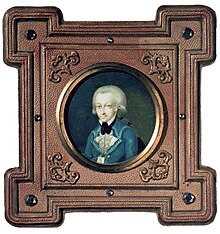| Piano Concerto in D major | |
|---|---|
| No. 5 | |
| by W. A. Mozart | |
 1773 miniature of Mozart | |
| Key | D major |
| Catalogue | K. 175 |
| Composed | 1773 |
| Movements | Three (Allegro, Andante ma un poco adagio, Allegro) |
| Scoring |
|
Piano Concerto No. 5 in D major, K. 175, was composed by Wolfgang Amadeus Mozart in 1773 at the age of 17. It is Mozart's first original piano concerto; his previous efforts were based on works by other composers. In 1782, he revised the score and composed a new rondo, adding a flute to the instrumentation (K. 382).
